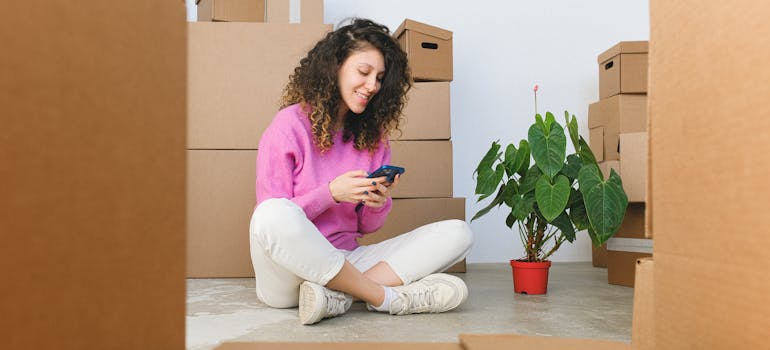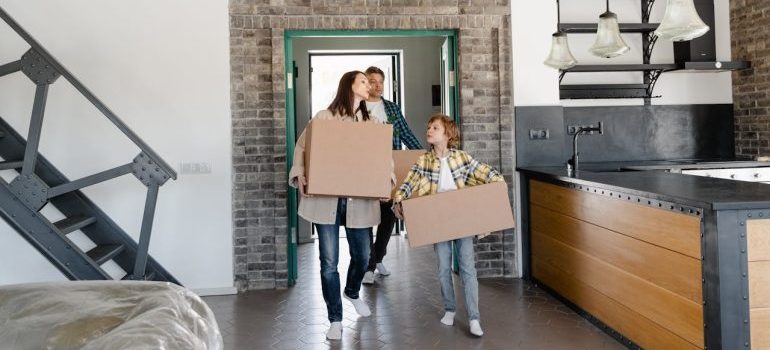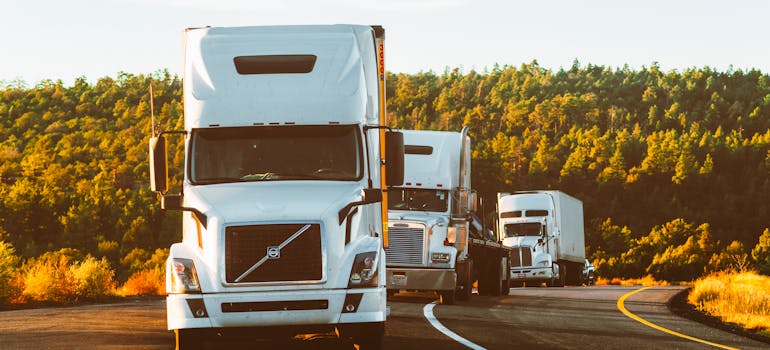If you thought local moving was a hassle, wait until you have to pack up your bags and relocate with a family to another state. It’s a process unlike any other, and it’s righteously considered one of the most stressful events a person can go through. Luckily, we will make your relocation more bearable. Our interstate moving guide will be detailed, as we don’t like to leave things half-done, and will include all the aspects an interstate relocation inevitably brings – from saying goodbye to your loved ones to hiring interstate movers Florida. Let’s begin!
Why Are People Moving Out of State?
When you are born and raised in one place, deciding to pick up and go is never an easy decision. It’s not just due to stress that an interstate relocation brings; neither is it due to spending days searching for competent long distance movers Florida that might be able to take you to the adjacent state. No, the stress is rooted in the emotional angst one person goes through when leaving behind their friends, family, and everything known up until that point. With what was just said, you’d think that there is no reason for a person to ever change their residence. But, that’s when you would be wrong. There are plenty of reasons why people decide to venture out and go through an interstate relocation.

Statistics show that the most common reason for moving to a different state is to move to a better home. As much as 14,4% of Americans change states for this reason. Then, we have 11,2% of those who decide to leave their parent’s nest and establish their household far away. There’s nothing better than gaining independence. That work is a powerful motivator can be seen through 9,2% of those who leave due to a new job or a transfer. And that prices in America’s housing market are high can be seen through 7,73% of those who move to a new state in pursuit of more favorable prices.
Get to Work on Time
Starting early is key to a stress-free interstate move. Ideally, kick off your preparations eight weeks before your moving day. This timeline allows you to thoroughly organize and declutter. In the first two weeks, focus on inventorying your belongings and deciding what to keep, sell, or donate. Around six weeks out, start gathering things you need for relocation, such as moving supplies like boxes, tape, and bubble wrap.
Booking your moving company early can also lead to better deals and ensure that you get the moving date that suits you best. As the four-week mark approaches, begin packing non-essential items. Label boxes clearly with contents and the room they belong to. This system saves time when unpacking in your new home. Make sure to notify relevant parties about your change of address during this period. This includes your employer, bank, and utility providers. Setting up utilities at your new address should also be done a few weeks before you arrive.
By the final week, your focus should be on packing essentials and preparing for the move day. Confirm arrangements with your movers a few days before to ensure everything is on track. Starting early not only keeps your move organized but also helps mitigate any last-minute hiccups that could arise.

Know the Regulations
When planning an interstate move, it’s vital to understand state-specific regulations on transporting goods. Each state has its own set of rules about what can cross its borders. For example, California has strict guidelines on bringing plants to prevent the spread of pests and diseases. Similarly, Florida restricts certain fruits and vegetables for the same reasons. If you’re moving pets, know that some states require specific vaccinations or health certificates.
To avoid any disruptions on a moving day, research these regulations well in advance. Contact the state’s Department of Agriculture or visit their website for detailed information. It’s also helpful to check with your moving company, as they often have experience with state regulations and can provide valuable advice.
Be mindful of restrictions on items like alcohol and tobacco, which can vary significantly from one state to another. For instance, some states limit the amount of alcohol you can bring in without permits. Taking the time to understand these rules will help ensure that your belongings arrive at your new home without issue. Stay informed and prepare accordingly to make your interstate move as easy as possible.

Budget Accordingly
Budgeting for an interstate move is crucial as costs can quickly escalate. To calculate your moving expenses, start by listing all potential expenses such as mover fees, fuel for travel, and possible overnight stays. The weight of your belongings and the distance to your new home are the main factors that determine moving costs. For instance, the average cost to move the contents of a three-bedroom house 1,000 miles ranges from $4,000 to $10,000, depending on the service level. Consider how services like professional packing, temporary storage, and insurance will impact your budget.
To keep expenses down, reduce the load by selling or donating items you no longer need. This not only cuts your moving costs but may also provide some extra cash to bolster your moving budget. Always request detailed quotes from multiple moving companies to compare prices and services. Opt for a fixed quote rather than an estimate to avoid unexpected costs on a moving day. Setting up a contingency fund of around 10% of your total estimated moving expenses can also safeguard against unforeseen charges. Planning and tracking your budget meticulously will help manage the financial aspect of moving without stress.

The cost of an interstate relocation
- If moving out of a studio apartment, expect to pay around $1,500.
- When moving out of a one-bedroom apartment/house, the price will be in the range of $1,500-$2,700.
- If moving out of a two-bedroom home, the price will come out to $3,500-$4,700.
- In case you are moving out of a three-bedroom home, the price will be around $6,500 or more.
Bear in mind that all of these prices were calculated based on a basic offer. Special services will only increase the final amount on the bill. Special moving services can cost anywhere between $1000 and $10,000 depending on the type of the service, and the move, of course. Unless you opt for packing services in Florida, which usually cost a few hundred dollars, there is one major task in front of you – packing.
Start by Searching for Movers for Your Interstate Relocation
Should you have a DIY relocation or should you hire movers? While that may be a valid question when it comes to a local move, it’s not a valid one when it comes to interstate relocation. Moving to another state by yourself is next to impossible. At least you shouldn’t do it if the safety of your items and your family members matters to you. Although, if you do choose a DIY relocation, you would be in good company! As many as 1.35 million Americans choose to have an unassisted relocation where the vehicle of choice will be their car, as opposed to 1 million of those who opt for a DIY move with the difference of renting a truck. Only 650,000 Americans opt for professional movers when going through an interstate relocation, which is a shame.
Relocation professionals are just that – professionals. They are trained for this type of job and they will know the best way of ensuring your possessions reach their new home safely. But, finding interstate movers is much more complicated than it seems. You run the risk of hiring fraudulent movers, for starters. There are certain traits of reputable movers you should look for. Luckily for you, Best Movers in Florida can help you find the right moving company for your relocation!

The traits of reputable interstate movers
- Make sure your movers of choice have years of experience working on their side.
- Find a company with positive moving reviews, as well as a few bad ones. That proves their authenticity.
- Make sure they specialize in interstate and not only local relocation.
- Take a look at their prices. Low-ball offers that greatly differ from the competition are a bad sign.
- A variety of moving services Florida or any other state you are stationed in at the moment.
As you can see, there are plenty of things to check. For that reason, you will see one warning rather frequently in our interstate moving guide – start doing things on time. The ‘better late than never‘ philosophy does not apply to this situation.
Choose Your Moving Services Wisely
Choosing the right moving services is a crucial step in your interstate relocation process. Assume you’ve selected a reputable moving company; you’ll find they offer a variety of services. These could range from storage solutions in Florida to specialized packing assistance or even transporting delicate items like pianos. It’s essential to evaluate which services match your specific needs.
Consider factors like the volume of items you’re moving, the distance to your new home, and your budget. For instance, if you’re moving from a large home or relocating valuable or bulky items, professional packing services and specialized moving solutions might be worth the investment. On the other hand, if you’re on a tight budget, you might choose to pack yourself, get yourself packing supplies and only use movers for transportation. Storage solutions can be particularly helpful if there is a gap between leaving your old home and moving into your new one. Many moving companies offer short-term or long-term storage services which can ease the relocation.
Before making your final decision, get detailed quotes for different services and ensure they include all associated costs. This will help you avoid any surprises and make an informed choice that fits your needs and budget. By selecting your moving services wisely, you ensure a smoother, more efficient move that aligns with your expectations and budget.

Packing Takes a Special Place in Our Interstate Moving Guide
Packing is one of the most important moving day tasks for an interstate relocation. Anyone who has had to pack before knows how big of a hassle this task is. We are not referring to casual packing for a trip where all you have to do is make sure you bring your trendiest outfits. Well, even that type of packing can be tedious if done repeatedly. Now imagine having to pack all of your possessions and have them moved to a different state! It sure sounds like a nightmare. With a bit of careful planning though, it doesn’t have to be.
Gather the necessary packing supplies
Naturally, you should start by gathering the equipment necessary for the safe packing of all of your belongings. You need much more than different types of moving boxes. You need protective packaging materials, like foam peanuts and packing paper, then equipment that helps you lift and carry items, such as moving straps, furniture sliders, and dollies, and finally common materials like tape and markers. Warning: don’t try to save up on materials. They stand between you and successful relocation, so make sure you buy moving supplies galore.
Our guide for interstate moving suggests that you handle one room at a time
As hectic and complicated as packing for an interstate relocation is, there is still a way to organize it. And the best way to organize packing is by making sure you deal with it room by room. Even the best interstate moving guides will tell you that packing everything without any order will only lead to disaster. Once again, start on time. We can’t seem to stress it enough.
Start with the items you use the least, and end with those you use daily
Well, the method here is pretty self-explanatory, so we won’t waste too much time. What we will say is that you should leave those items like utensils and some of your clothes for the very end. You will need those without a doubt. On the other hand, the gym and sports equipment can be packed early on.

Pack an essentials bag and complete a very important entry on our interstate moving guide
Oh yes, an essentials bag is of utmost importance to us, and it should be to you too! It will be your survival kit during the first day and night in the new home. Let’s face it – the last thing you will want to do after going through a long and tiring move is to search through hundreds of moving boxes just to find a toothbrush. Instead, you should pack your moving essentials bag, and not worry about anything in those first few days. What should your moving essentials bag contain?
- Toothbrush and toothpaste
- Clean underwear and a change of clothes
- Sheets
- Basic cleaning supplies
- Basic hygiene products
- A toy or two if moving with kids (feel free to thank us later)
- A first-aid kit should anyone get injured (although you should try your best to avoid moving injuries)
Popular decluttering methods from our interstate moving guide
The thought of living in a clutter-free environment sure sounds appealing, doesn’t it? Well, take a look at the following decluttering methods that made it on our interstate moving guide. All that it takes is for you to choose one, or mix two or more. This is especially important if you’re moving into a smaller home! Entirely up to you!
- KonMari Method – instead of focusing on throwing away items, focus on what you want to keep and get rid of everything that doesn’t cut.
- Minimalist game – the number of things you throw away corresponds to the day of the month. On the first day, throw one item, on the second two, and so on. By the end of the month, you will have easily gotten rid of 496 items. Quite a staggering number, isn’t it?
- The three-box method – a personal favorite of many demands that you create three piles – keep, donate, throw away. The way it functions is pretty self-explanatory, so we won’t go further into the matter.
- One method – get rid of one item each day, no matter how big or small. If you follow it for two months or more, it will show significant benefits.
- Packing party – have your friends come over and pretend that you are moving. Pack everything up into boxes and take the things you need out of them for the next few months. After a while, you will be left with packed boxes that contain all the things you did not need.
Keep Important Documents Handy
Keeping your important documents handy during a move is essential. Pack items like your ID, moving contracts, and vital records in a separate, accessible bag. This strategy prevents crucial documents from getting lost among your other belongings. You’ll frequently need these documents throughout the move when interacting with movers, authorities, or new landlords. For example, your moving company might require a copy of your contract on moving day to confirm services and fees. Similarly, you may need your ID and proof of residency when setting up utilities or meeting new property managers. It’s also smart to include medical records, school records, and pet documentation if applicable.
Prepare this essentials bag early in your moving process and keep it with you at all times. It can also be helpful to include a list of emergency contacts, essential receipts, and a small amount of cash or a credit card for unexpected expenses. By organizing these items in advance, you can ensure a worry-free relocation and avoid any unnecessary complications during your move. This approach not only keeps you prepared but also provides peace of mind knowing that your most important paperwork is at your fingertips when you need it.

Update Your Information
Updating your information before moving is a critical step to ensure a successful relocation to your new home. Start by changing your address with the post office to forward your mail. Next, inform your bank, credit card companies, and any other financial institutions of your new address. This prevents disruptions in your financial transactions and ensures you receive important notices.
Don’t overlook setting up or transferring your utilities and internet services in your new home ahead of your arrival. Contact the utility companies in your new area to start service on your move-in day. This includes electricity, water, gas, and trash services. Setting up your internet service in advance is especially important, as many of us rely on it daily for work and entertainment.
Taking these steps not only minimizes the stress of moving day but also helps you quickly settle into your new environment. It ensures you can start your new chapter without unnecessary complications or delays. Remember, a little preparation goes a long way in making your move efficient.
Include Your Family and Friends Into the Process
When it comes to moving, including your loved ones in the moving process can make your relocation easier and more enjoyable. Begin by assigning tasks based on each person’s strengths. Maybe a friend loves organizing, or a family member is great at packing boxes. This approach not only speeds up the process but also makes it more fun. You can also set up a packing party with snacks and music to make the day less tedious. Your friends and family can help pack boxes, label them, and perhaps even help with some of the heavy lifting. Their presence can also provide emotional support, which is invaluable during the stress of a move.
For those moving with kids, involve them by letting them pack their special box with their favorite things. This makes them feel part of the process and can ease their anxiety about moving. Explain to them what is happening and why, to help them understand the change. Remember to show appreciation for their help. Whether it’s ordering pizza during a packing session or planning a thank you dinner after the move, a small gesture of gratitude goes a long way. Your friends and family are investing their time and energy to help you, and acknowledging their effort strengthens your relationships. By including those close to you in your move, you not only get extra help, but you also create lasting memories with your loved ones in both your old and new homes.

Prepare for the Arrival
Preparing for your arrival at the new home can dramatically ease the unpacking process. If possible, visit your new home before the move to take measurements of each room. Knowing the dimensions allows you to plan exactly where your furniture will fit best. You can even draw a floor plan to visualize the layout. This foresight ensures that on moving day, each box and piece of furniture goes directly to its intended spot, saving time and effort.
Before you arrive, confirm that utilities like water, power, and internet are set up and working. This step is crucial for a comfortable first night in your new home. Also, plan where essential items like your bed, toiletries, and basic kitchenware will go. Having these essentials easily accessible will help you feel settled more quickly. Don’t forget to label each box clearly with its contents and the room it’s destined for. This simple action can prevent confusion and speed up the unpacking process. Consider packing an “open first” box that contains everything you’ll need immediately, such as bedding, pajamas, and personal care items.
Take Care of Yourself
Moving day can be physically and emotionally taxing, so it’s vital to protect yourself and your belongings, and prioritize your well-being according to our interstate moving guide. Start by staying hydrated throughout the day. Carrying heavy boxes and furniture can quickly lead to dehydration, especially in warm weather. Keep a water bottle handy and take regular water breaks. Eating balanced snacks, such as fruits, nuts, and granola bars, will also help maintain your energy levels during the move.
Remember to take short breaks every couple of hours. This will not only help you avoid overexertion but also clear your mind, reducing stress. Planning these pauses can be as simple as setting a timer every hour or two to remind you to rest for a few minutes.
After a long day of moving, ensure you have a proper setup for a good night’s sleep. Whether it’s setting up your bed first or having clean bedding ready, resting well after the move is crucial for recovery. If possible, try to disconnect from unpacking duties and unwind before bedtime. Reading a book or listening to calming music can help you relax and ensure a rejuvenating sleep. Taking care of yourself during this transition will help you feel better both physically and mentally. It allows you to tackle unpacking with renewed energy and makes the overall moving experience more positive.

Once You Get Settled in, Organize a Move-in Party
There is much more to an interstate move than packing and loading. It’s the prospect of starting over that should be of interest to you. Maybe you have dreamed about finally changing your surroundings after decades of being stuck in one place. Or you wanted to escape the small suburban town and move to someplace exciting. Guess what? This is your chance to turn over a new leaf, and it all starts by organizing a move-in party. Organizing a party is also a great way to unwind and relax!
Buy some liquor, prepare delicious snacks, and let the neighbors know that you have arrived. Besides, making a few friends as soon as you arrive will help you deal with nostalgia after a move. And you can rest assured that you will feel melancholic, whether you want to or not. After all, this is a big change you have just gone through!

Get to Know Your New Area
Once you’ve moved and started to settle in, interstate moving guide says it’s time to get to know your new area. Exploring your neighborhood is a great way to begin. Walk around and discover local parks, cafes, and shops. This simple activity not only helps you familiarize yourself with the surroundings but also boosts your comfort and confidence in navigating the new environment. Make an effort to meet your neighbors. Introducing yourself can lead to new friendships and valuable local insights. Neighbors can recommend everything from the best coffee shop to a trustworthy mechanic. They can also help you understand community norms and events, which is crucial for integrating smoothly.
Find essential services early on. Locate the nearest grocery store, pharmacy, hospital, and other important facilities. Knowing these locations in advance is not just practical—it helps you feel more secure and prepared for daily life. Participate in local events. Whether it’s a farmer’s market, a book club at the library, or a community clean-up, getting involved helps you connect with your community. It also allows you to contribute positively to your new neighborhood, making it a better place for everyone.
In case you have children, explore opportunities for them too. Check out local schools, playgrounds, and kid-friendly activities. This helps them adjust and find new friends, making the transition easier for them as well. By taking these steps, you not only make your new place feel like home but also build a network and community that will support you in your new life.
Interesting Facts About Moving Around America
No interstate moving guide would be complete without a few interesting facts about the moving trends. Were you always interested to know which states the Americans are most likely to leave? Well, according to statistical data, Illinois is the number 1 state that most Americans are leaving. It is closely followed by Alaska, New Jersey, New York, and West Virginia – in that order.
On the other hand, some states have witnessed a huge increase in migration. The most desired state seems to be Idaho, as it has had the biggest surplus of residents in recent years. The second place of the states the Americans are moving to belongs to Nevada, third to Arizona, fourth to Oregon, and fifth to Montana. Who would have thought that people would be moving out of New York to settle in Oregon?
Although, don’t let these statistics force you into making a decision. Even though people are increasingly moving out of Illinois, for example, doesn’t mean that your happiness isn’t there. Similarly, just because people have been moving to Nevada, doesn’t mean that they will find what you are looking for there. Take only your situation into account, as that’s all that matters!

Hopefully, Our Interstate Moving Guide Will Be of Great Use to You!
The sole reason behind us making an interstate moving guide was to make this difficult process as easy as it can be. Granted, we are no magicians, and even we can’t make your relocation into something completely void of stress. That largely depends on you and your personality. What we can do, however, is give you a few tips and warnings. And that’s precisely what we just did! By paying attention to the entries in our guide, we can assure you that the level of stress you will be feeling will be minimal. All that’s left to say is good luck, and know that we are cheering for you!
